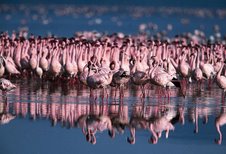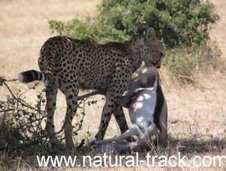In our nature series this season, our African safari desk has stretched its adventurous strides to Uganda and in the next few episodes; we are going to light our campfire around informative details, news, and facts about this wonderful East African country widely known as – the home of the rare mountain gorillas.
Uganda’s major attraction is the endangered mountain gorilla, the most profoundly built of living primates and among the most peaceable too. Staring into the pondering brown eyes of these calm giants, who share 95% of their genes with humans, is as awe-inspiring as it is exhilarating; no less so, when one realizes that fewer than 700 known individuals survive today. The groups are divided between Bwindi National Park and the Virunga Mountains south west of Congo border.
Within Uganda, there are five habituated Gorilla troops available for viewing – four in Bwindi and one in Mgahinga National Park. The groups have been given local titles which have very interesting meanings. Eight people are permitted per group per day and a total of twenty four people are taken in Bwindi, while eight people are allowed for Mgahinga.
Uganda is also home to man’s closest relative, the chimpanzee, a delightful ape whose evocative pant-hoot call is a definitive sound of the African rainforest. Chimpanzee communities have been habituated for tourism at Kibale Forest, Budongo Forest and Queen Elizabeth National Park’s Kyambura Gorge. There is also a community of orphaned chimps, most of which were confiscated from poachers, and can be visited on Ngamba Island, which lies on Lake Victoria 45 minutes by motorboat from Entebbe.
Of more exhalation is the exceptionally well representation of monkeys in Uganda. Kibale Forest boasts the greatest primate variety and density in East Africa, with five or six species likely to be observed over the course of one afternoon walk. Elsewhere, Mgahinga National Park hosts habituated troops of the rare golden monkey, while Murchison Falls is one of the few East African strongholds for the spindly, plains-dwelling Patas monkey. The fossilized 20-million-year-old bones of Morotopithecus, the earliest-known ancestor of modern apes and humans, were unearthed in the 1960s near Moroto in Eastern Uganda, and are now housed in the National Museum in Kampala.
Tracking Gorillas is one of immensely fascinating and sometimes very emotional experience for many taking safaris in Africa, whilst for others it often fulfils a lifetime ambition. The most famous areas for gorilla tracking are in the Bwindi Impenetrable forest. The best way for a perfect tracking is guided nature walks between Buhoma in the Bwindi Impenetrable Forest and the town of Kisoro via Nkuringo and vice versa.
This experience offers a low cost insiders perspective into village life in rural Uganda highlighting some of the wonders of Bwindi Impenetrable Forest all at your own pace. Gorilla tracking is a very captivating activity; it involves walking in the wilderness in search of these great apes. It can be a challenging activity, therefore ensure physical fitness.
It is paramount to know that the Uganda wildlife authority requires you to have a tracking permit; Booking for all gorilla permits in Bwindi and Mgahinga is done at UWA Headquarters in Kampala. Advance permits are available as early as two years.
Another great encounter is the Chimpanzee tracking. The way they feed, climb trees, respond to humans and the care they show for their young ones, is just phenomenal. Kibale national park, Queen Elizabeth and Murchison falls national park are a haven of Chimpz. I know the fact that Chimpz are 'cousins to humans' is not a new tale to you. For the more adventurers, you can be part of the habituation team that goes in the morning to study the behavior of this primate in order to make them get used to human beings.
kenia safari
Natural Track Safaris









No comments:
Post a Comment